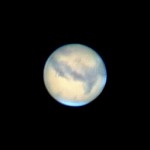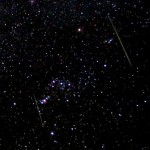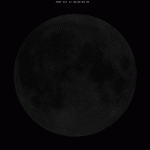Today Mercury passes through superior conjunction, passing behind the Sun as seen from the Earth. It will appear in the sunset later in the month, reaching maximum elongation on March 4th.
Category: Sky Events
Sky events
Mars Opposition 2012
About a month from today, on March 3rd, the planet Mars will pass through opposition.
Mars orbits the Sun every 1.88 years, with Earth only taking one year for each orbit. Like two runners on a track the two planets race each other around the Sun. But we have the inside lane, lapping the red planet every two years. These events are called opposition, when Mars is closest to us and best positioned for viewing by earthbound telescopes.
Closest approach of the two planets is not necessarily on the same day as opposition, but can vary up to two weeks. This year closest approach will occur March 5th with the two planets approaching to 99,331,411 km (61,721,554 miles) at 07:01HST.1 At this distance the red planet will show a disk 13.89″ arc-seconds across in the eyepiece.2
 Mars during the 2005 opposition
Mars during the 2005 opposition
Do not worry about viewing on the 3rd or 5th, any time in the month leading up to and after opposition the viewing will be very good. With even a modest telescope it should be possible to see the bright polar caps and light and dark markings on the planet.
All month Mars will be visible throughout the night, high in the sky at midnight. This is the time to enjoy observing our closest neighboring planet while it is nearby and high in the night sky.
1) 2012 Mars Opposition at SEDS
2) The 2012 Aphelic Apparition of Mars
Neptune Slides Into the Sunset
The first week of February will see Neptune slide into the sunset. The planet will pass through superior conjunction on February 19th to re-appear in the dawn during first weeks of March.
The Moon and Pleiades
Tonight a bright gibbous Moon will be just under 5° from the Pleiades star cluster. The Moon will be 62% illuminated, bright, but the cluster is bright enough to be seen even against a bright Moon. As the Pleiades move to the west over coming months there will be a few more lunar conjunctions, with increasingly smaller crescents.
The Moon and Jupiter
Tonight will see a brilliant Jupiter near the Moon. The pair will be separated by about 5.5° high in the evening sky. Jupiter will shine brightly at -2.4 magnitude, a nice match for a 41% illuminated Moon.
The Moon and Venus
The Moon and Venus were quite close last night, about 8° with the Moon below the brilliant Venus. Tonight the Moon will be above Venus, about 9° away.
The Moon and Venus
This evening a nice crescent Moon will join Venus in the dusky sky. The pair will be reasonably close, about 8° apart. Venus is currently shining very brightly at about -4.1 magnitude, contrasting nicely with a 9% illuminated Moon. The two will still be close tomorrow, about 9° apart with the Moon 15% illuminated.
Meteor Watching
Watching meteors is one of the simplest forms of astronomical observing. Just about anyone can enjoy meteor watching, from just about anywhere in the world. Enjoying the show takes only a couple things… A dark sky and a comfortable place from which to watch.

The mechanism for the show is simple. When something hits the very thin air high in our atmosphere at very high speed it compresses the air in front of it. This compression also heats the air, causing it to glow white hot. Heated enough, the air becomes a plasma, the molecules shredded and electrons freed from the atoms. It is not the meteor itself that you see, but the glowing plasma around it.
There are a number of questions many people ask about meteor observing. You can find many of the answers below. Watching a meteor shower takes no special equipment, expert knowledge or extravagant preparation. This is an activity nearly anyone can enjoy, one of the spectacles of nature available to all.
New Moon
Lunar Apogee and Perigee
Does the Moon seem a little larger and brighter than usual? It may not be an illusion, sometimes the Moon really does look a little larger or smaller in the sky.
Like all orbiting objects, the Moon does not orbit in a perfect circle, but rather in an ellipse. This means that as it orbits it is a little further away or a little closer. In the case of the Moon the difference is not much, but you can see it, if you know to look.


The period of time between full Moons, the synodic month, is about 29.5 days. While lunar perigee occurs every 27.5 days, an anomalistic month. Since these periods are not equal, the cycle drifts in and out of phase. About once a year the cycles coincide and full Moon and apogee or perigee will occur near the same time.
At apogee, the Moon will be appear about 29 arc-minutes in size, a little less than half a degree. At perigee the Moon will be about 33 arc-minutes across, a bit more than half a degree. The numbers may not seem like much, but it is a visible difference. The simulated images shown here will give a better idea of what the numbers represent.
This change in size and distance leads to the moonlight being a bit brighter at perigee than at apogee, about a 30% difference. So if that moonlit night seems brighter than you remember it may actually be the case.

